Remote Intelligence: Workforce Sustainability and Business Analysis
VerifiedAdded on 2023/06/11
|12
|3551
|292
Essay
AI Summary
This essay provides a comprehensive analysis of remote intelligence, differentiating it from telecommuting and exploring its implications for businesses. It discusses how companies have enabled remote intelligence through technological advancements and clear objective settings, and examines the impact of remote intelligence on workforce sustainability in developed countries. The essay also delves into the ethical considerations of using remote intelligence, highlighting the importance of adhering to work timings, avoiding personal errands during work hours, and maintaining honesty. Furthermore, it outlines the benefits and disadvantages of remote intelligence, such as financial savings and increased productivity versus potential isolation and communication challenges. Finally, it suggests leadership styles and requirements for effectively managing remote intelligence, emphasizing the importance of good communication channels and strategies.
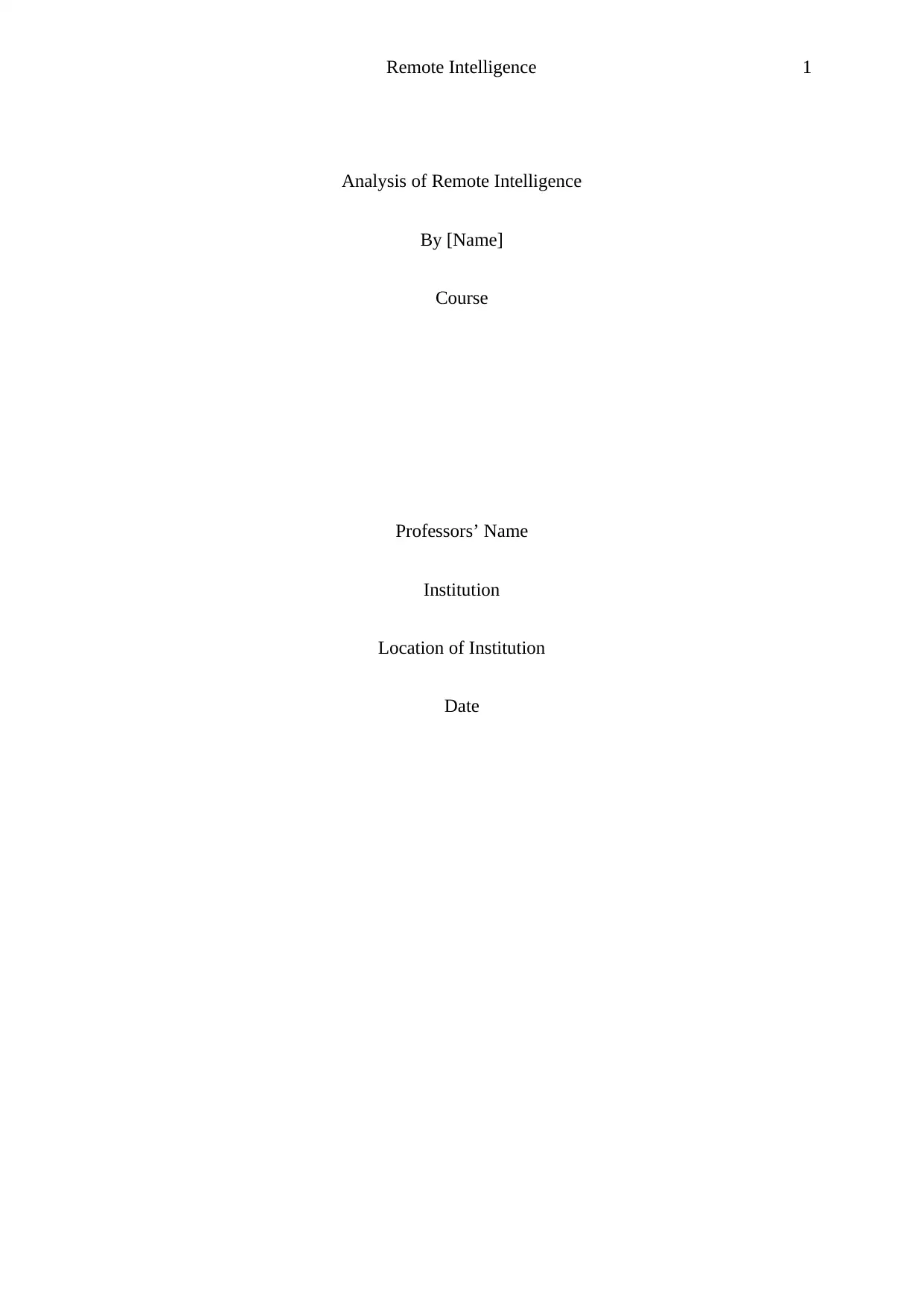
Remote Intelligence 1
Analysis of Remote Intelligence
By [Name]
Course
Professors’ Name
Institution
Location of Institution
Date
Analysis of Remote Intelligence
By [Name]
Course
Professors’ Name
Institution
Location of Institution
Date
Paraphrase This Document
Need a fresh take? Get an instant paraphrase of this document with our AI Paraphraser
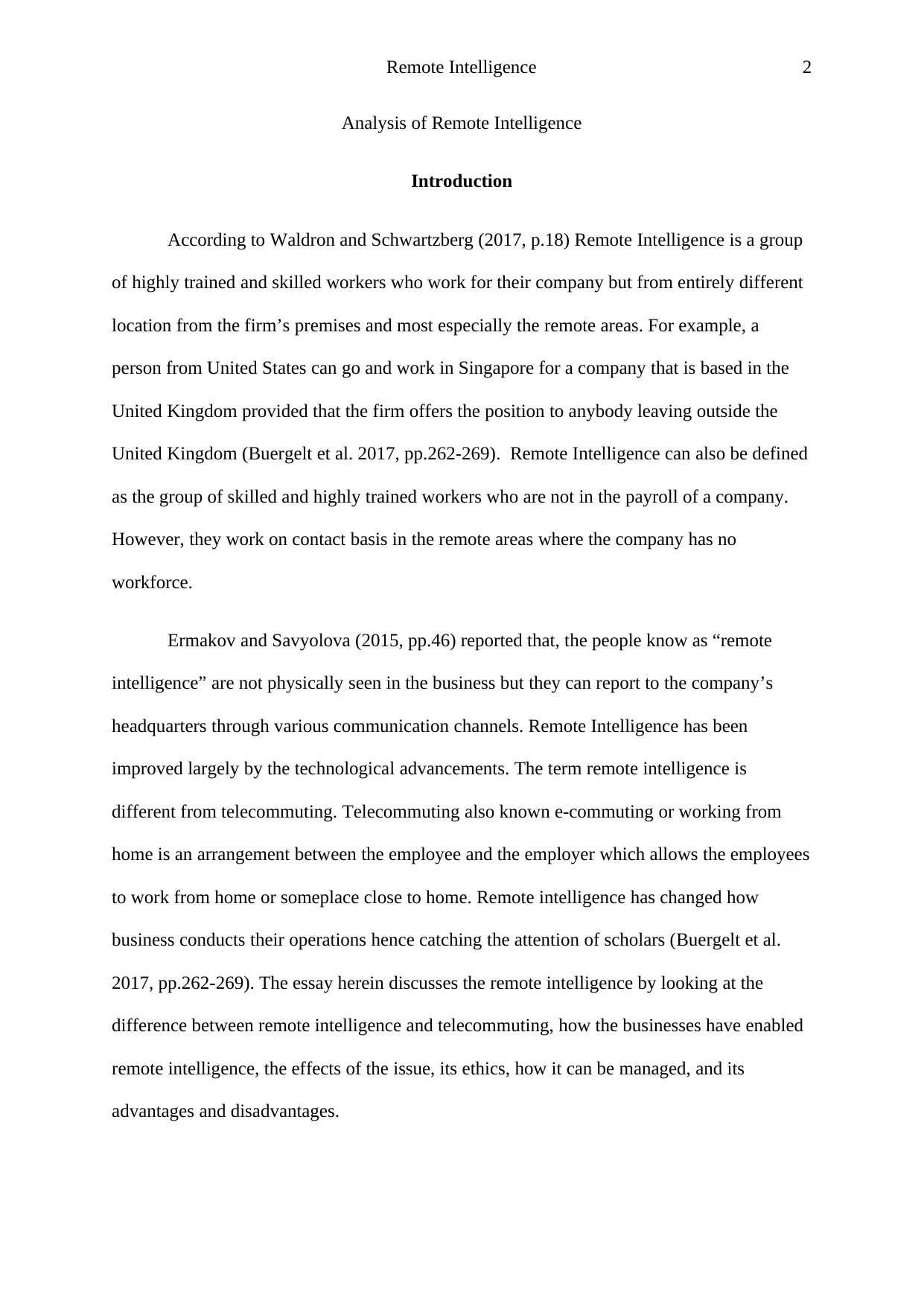
Remote Intelligence 2
Analysis of Remote Intelligence
Introduction
According to Waldron and Schwartzberg (2017, p.18) Remote Intelligence is a group
of highly trained and skilled workers who work for their company but from entirely different
location from the firm’s premises and most especially the remote areas. For example, a
person from United States can go and work in Singapore for a company that is based in the
United Kingdom provided that the firm offers the position to anybody leaving outside the
United Kingdom (Buergelt et al. 2017, pp.262-269). Remote Intelligence can also be defined
as the group of skilled and highly trained workers who are not in the payroll of a company.
However, they work on contact basis in the remote areas where the company has no
workforce.
Ermakov and Savyolova (2015, pp.46) reported that, the people know as “remote
intelligence” are not physically seen in the business but they can report to the company’s
headquarters through various communication channels. Remote Intelligence has been
improved largely by the technological advancements. The term remote intelligence is
different from telecommuting. Telecommuting also known e-commuting or working from
home is an arrangement between the employee and the employer which allows the employees
to work from home or someplace close to home. Remote intelligence has changed how
business conducts their operations hence catching the attention of scholars (Buergelt et al.
2017, pp.262-269). The essay herein discusses the remote intelligence by looking at the
difference between remote intelligence and telecommuting, how the businesses have enabled
remote intelligence, the effects of the issue, its ethics, how it can be managed, and its
advantages and disadvantages.
Analysis of Remote Intelligence
Introduction
According to Waldron and Schwartzberg (2017, p.18) Remote Intelligence is a group
of highly trained and skilled workers who work for their company but from entirely different
location from the firm’s premises and most especially the remote areas. For example, a
person from United States can go and work in Singapore for a company that is based in the
United Kingdom provided that the firm offers the position to anybody leaving outside the
United Kingdom (Buergelt et al. 2017, pp.262-269). Remote Intelligence can also be defined
as the group of skilled and highly trained workers who are not in the payroll of a company.
However, they work on contact basis in the remote areas where the company has no
workforce.
Ermakov and Savyolova (2015, pp.46) reported that, the people know as “remote
intelligence” are not physically seen in the business but they can report to the company’s
headquarters through various communication channels. Remote Intelligence has been
improved largely by the technological advancements. The term remote intelligence is
different from telecommuting. Telecommuting also known e-commuting or working from
home is an arrangement between the employee and the employer which allows the employees
to work from home or someplace close to home. Remote intelligence has changed how
business conducts their operations hence catching the attention of scholars (Buergelt et al.
2017, pp.262-269). The essay herein discusses the remote intelligence by looking at the
difference between remote intelligence and telecommuting, how the businesses have enabled
remote intelligence, the effects of the issue, its ethics, how it can be managed, and its
advantages and disadvantages.
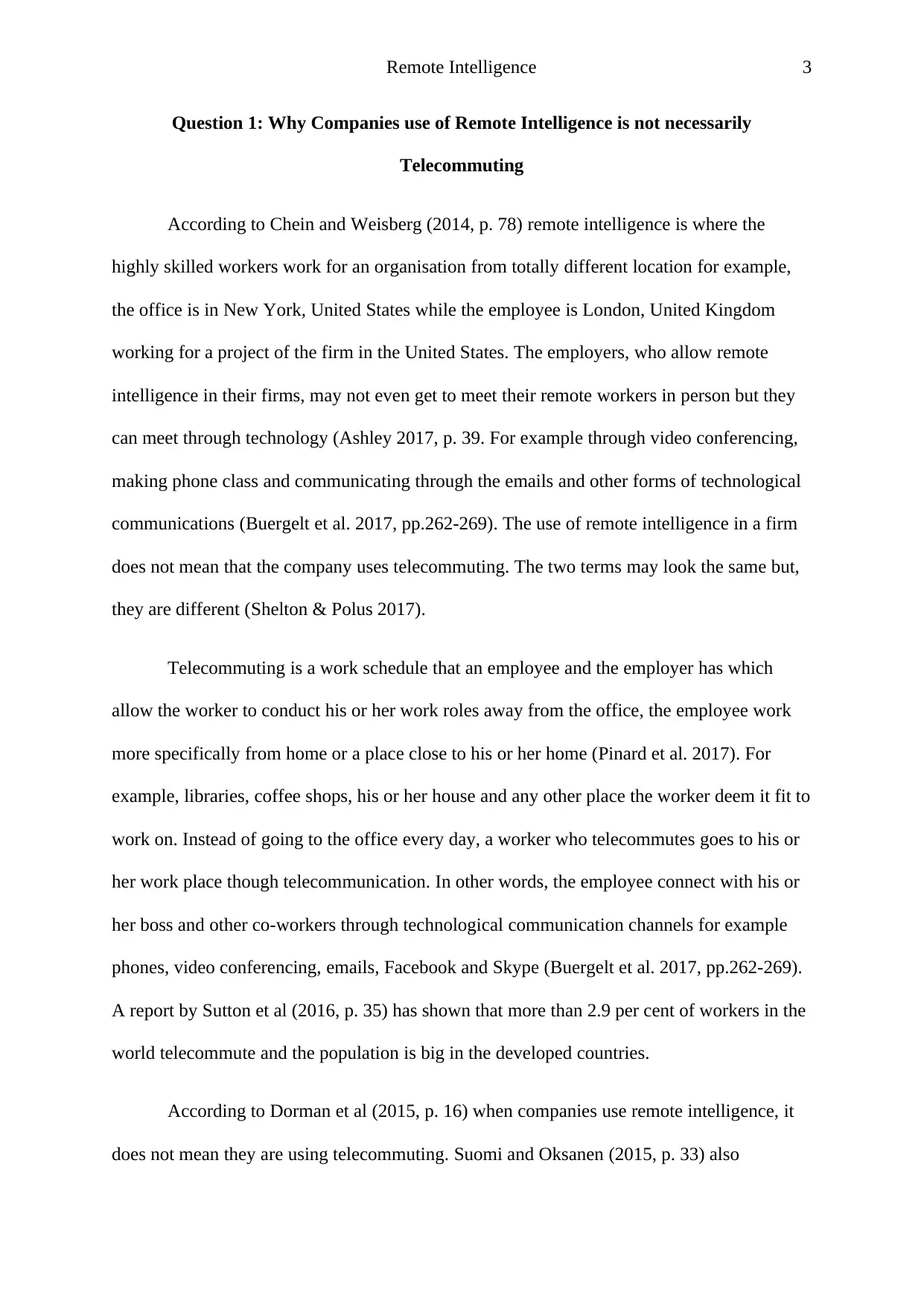
Remote Intelligence 3
Question 1: Why Companies use of Remote Intelligence is not necessarily
Telecommuting
According to Chein and Weisberg (2014, p. 78) remote intelligence is where the
highly skilled workers work for an organisation from totally different location for example,
the office is in New York, United States while the employee is London, United Kingdom
working for a project of the firm in the United States. The employers, who allow remote
intelligence in their firms, may not even get to meet their remote workers in person but they
can meet through technology (Ashley 2017, p. 39. For example through video conferencing,
making phone class and communicating through the emails and other forms of technological
communications (Buergelt et al. 2017, pp.262-269). The use of remote intelligence in a firm
does not mean that the company uses telecommuting. The two terms may look the same but,
they are different (Shelton & Polus 2017).
Telecommuting is a work schedule that an employee and the employer has which
allow the worker to conduct his or her work roles away from the office, the employee work
more specifically from home or a place close to his or her home (Pinard et al. 2017). For
example, libraries, coffee shops, his or her house and any other place the worker deem it fit to
work on. Instead of going to the office every day, a worker who telecommutes goes to his or
her work place though telecommunication. In other words, the employee connect with his or
her boss and other co-workers through technological communication channels for example
phones, video conferencing, emails, Facebook and Skype (Buergelt et al. 2017, pp.262-269).
A report by Sutton et al (2016, p. 35) has shown that more than 2.9 per cent of workers in the
world telecommute and the population is big in the developed countries.
According to Dorman et al (2015, p. 16) when companies use remote intelligence, it
does not mean they are using telecommuting. Suomi and Oksanen (2015, p. 33) also
Question 1: Why Companies use of Remote Intelligence is not necessarily
Telecommuting
According to Chein and Weisberg (2014, p. 78) remote intelligence is where the
highly skilled workers work for an organisation from totally different location for example,
the office is in New York, United States while the employee is London, United Kingdom
working for a project of the firm in the United States. The employers, who allow remote
intelligence in their firms, may not even get to meet their remote workers in person but they
can meet through technology (Ashley 2017, p. 39. For example through video conferencing,
making phone class and communicating through the emails and other forms of technological
communications (Buergelt et al. 2017, pp.262-269). The use of remote intelligence in a firm
does not mean that the company uses telecommuting. The two terms may look the same but,
they are different (Shelton & Polus 2017).
Telecommuting is a work schedule that an employee and the employer has which
allow the worker to conduct his or her work roles away from the office, the employee work
more specifically from home or a place close to his or her home (Pinard et al. 2017). For
example, libraries, coffee shops, his or her house and any other place the worker deem it fit to
work on. Instead of going to the office every day, a worker who telecommutes goes to his or
her work place though telecommunication. In other words, the employee connect with his or
her boss and other co-workers through technological communication channels for example
phones, video conferencing, emails, Facebook and Skype (Buergelt et al. 2017, pp.262-269).
A report by Sutton et al (2016, p. 35) has shown that more than 2.9 per cent of workers in the
world telecommute and the population is big in the developed countries.
According to Dorman et al (2015, p. 16) when companies use remote intelligence, it
does not mean they are using telecommuting. Suomi and Oksanen (2015, p. 33) also
⊘ This is a preview!⊘
Do you want full access?
Subscribe today to unlock all pages.

Trusted by 1+ million students worldwide
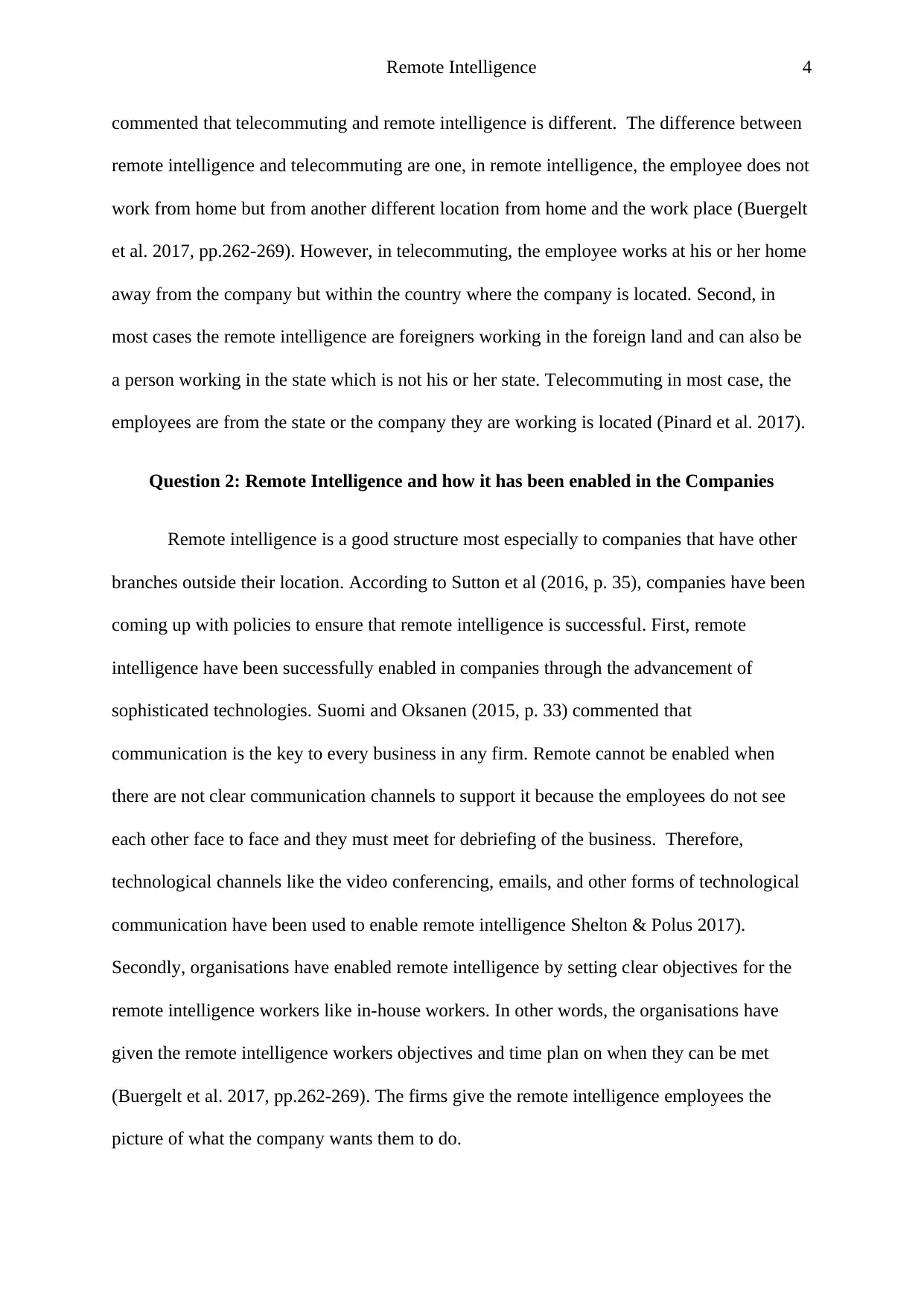
Remote Intelligence 4
commented that telecommuting and remote intelligence is different. The difference between
remote intelligence and telecommuting are one, in remote intelligence, the employee does not
work from home but from another different location from home and the work place (Buergelt
et al. 2017, pp.262-269). However, in telecommuting, the employee works at his or her home
away from the company but within the country where the company is located. Second, in
most cases the remote intelligence are foreigners working in the foreign land and can also be
a person working in the state which is not his or her state. Telecommuting in most case, the
employees are from the state or the company they are working is located (Pinard et al. 2017).
Question 2: Remote Intelligence and how it has been enabled in the Companies
Remote intelligence is a good structure most especially to companies that have other
branches outside their location. According to Sutton et al (2016, p. 35), companies have been
coming up with policies to ensure that remote intelligence is successful. First, remote
intelligence have been successfully enabled in companies through the advancement of
sophisticated technologies. Suomi and Oksanen (2015, p. 33) commented that
communication is the key to every business in any firm. Remote cannot be enabled when
there are not clear communication channels to support it because the employees do not see
each other face to face and they must meet for debriefing of the business. Therefore,
technological channels like the video conferencing, emails, and other forms of technological
communication have been used to enable remote intelligence Shelton & Polus 2017).
Secondly, organisations have enabled remote intelligence by setting clear objectives for the
remote intelligence workers like in-house workers. In other words, the organisations have
given the remote intelligence workers objectives and time plan on when they can be met
(Buergelt et al. 2017, pp.262-269). The firms give the remote intelligence employees the
picture of what the company wants them to do.
commented that telecommuting and remote intelligence is different. The difference between
remote intelligence and telecommuting are one, in remote intelligence, the employee does not
work from home but from another different location from home and the work place (Buergelt
et al. 2017, pp.262-269). However, in telecommuting, the employee works at his or her home
away from the company but within the country where the company is located. Second, in
most cases the remote intelligence are foreigners working in the foreign land and can also be
a person working in the state which is not his or her state. Telecommuting in most case, the
employees are from the state or the company they are working is located (Pinard et al. 2017).
Question 2: Remote Intelligence and how it has been enabled in the Companies
Remote intelligence is a good structure most especially to companies that have other
branches outside their location. According to Sutton et al (2016, p. 35), companies have been
coming up with policies to ensure that remote intelligence is successful. First, remote
intelligence have been successfully enabled in companies through the advancement of
sophisticated technologies. Suomi and Oksanen (2015, p. 33) commented that
communication is the key to every business in any firm. Remote cannot be enabled when
there are not clear communication channels to support it because the employees do not see
each other face to face and they must meet for debriefing of the business. Therefore,
technological channels like the video conferencing, emails, and other forms of technological
communication have been used to enable remote intelligence Shelton & Polus 2017).
Secondly, organisations have enabled remote intelligence by setting clear objectives for the
remote intelligence workers like in-house workers. In other words, the organisations have
given the remote intelligence workers objectives and time plan on when they can be met
(Buergelt et al. 2017, pp.262-269). The firms give the remote intelligence employees the
picture of what the company wants them to do.
Paraphrase This Document
Need a fresh take? Get an instant paraphrase of this document with our AI Paraphraser
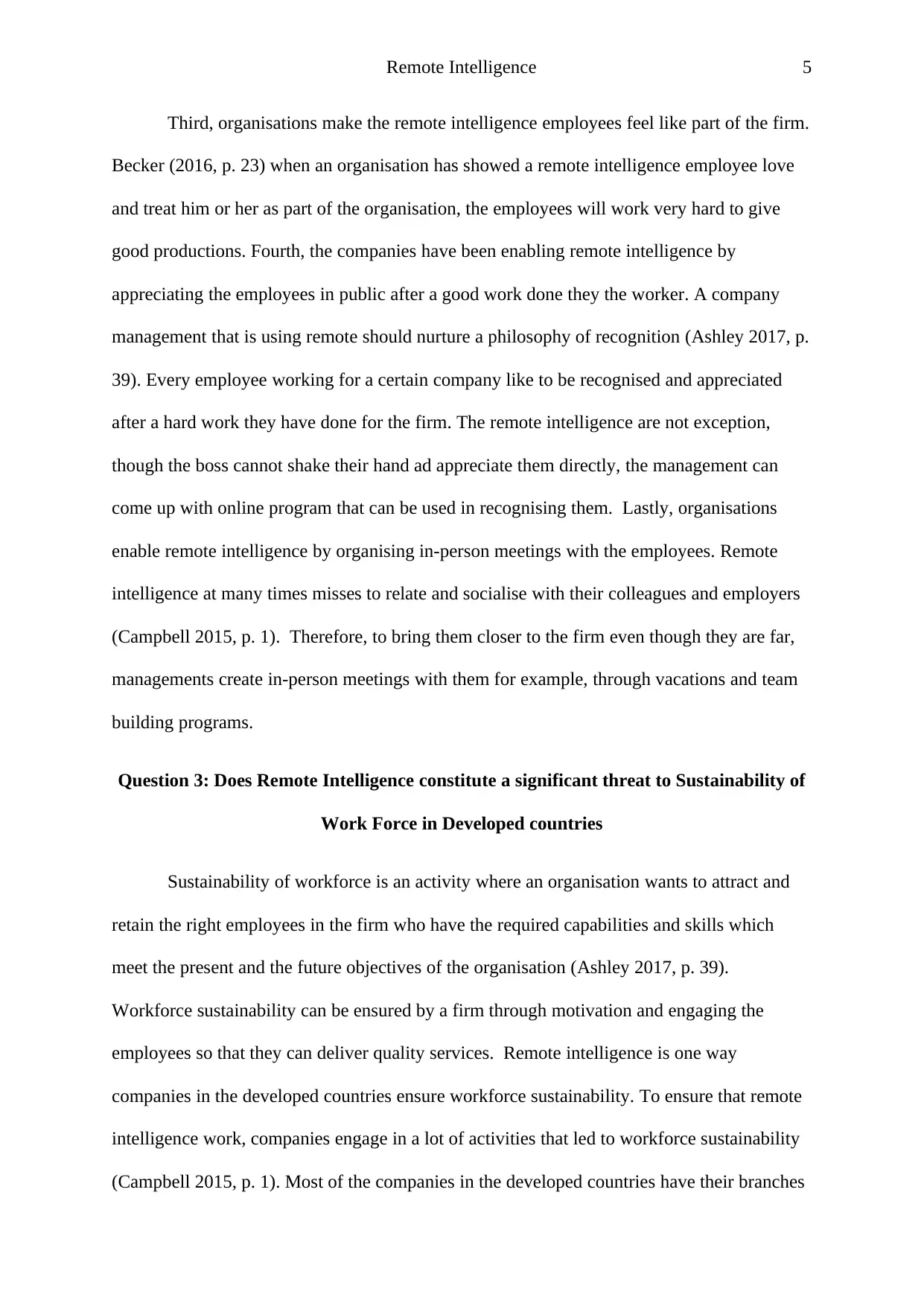
Remote Intelligence 5
Third, organisations make the remote intelligence employees feel like part of the firm.
Becker (2016, p. 23) when an organisation has showed a remote intelligence employee love
and treat him or her as part of the organisation, the employees will work very hard to give
good productions. Fourth, the companies have been enabling remote intelligence by
appreciating the employees in public after a good work done they the worker. A company
management that is using remote should nurture a philosophy of recognition (Ashley 2017, p.
39). Every employee working for a certain company like to be recognised and appreciated
after a hard work they have done for the firm. The remote intelligence are not exception,
though the boss cannot shake their hand ad appreciate them directly, the management can
come up with online program that can be used in recognising them. Lastly, organisations
enable remote intelligence by organising in-person meetings with the employees. Remote
intelligence at many times misses to relate and socialise with their colleagues and employers
(Campbell 2015, p. 1). Therefore, to bring them closer to the firm even though they are far,
managements create in-person meetings with them for example, through vacations and team
building programs.
Question 3: Does Remote Intelligence constitute a significant threat to Sustainability of
Work Force in Developed countries
Sustainability of workforce is an activity where an organisation wants to attract and
retain the right employees in the firm who have the required capabilities and skills which
meet the present and the future objectives of the organisation (Ashley 2017, p. 39).
Workforce sustainability can be ensured by a firm through motivation and engaging the
employees so that they can deliver quality services. Remote intelligence is one way
companies in the developed countries ensure workforce sustainability. To ensure that remote
intelligence work, companies engage in a lot of activities that led to workforce sustainability
(Campbell 2015, p. 1). Most of the companies in the developed countries have their branches
Third, organisations make the remote intelligence employees feel like part of the firm.
Becker (2016, p. 23) when an organisation has showed a remote intelligence employee love
and treat him or her as part of the organisation, the employees will work very hard to give
good productions. Fourth, the companies have been enabling remote intelligence by
appreciating the employees in public after a good work done they the worker. A company
management that is using remote should nurture a philosophy of recognition (Ashley 2017, p.
39). Every employee working for a certain company like to be recognised and appreciated
after a hard work they have done for the firm. The remote intelligence are not exception,
though the boss cannot shake their hand ad appreciate them directly, the management can
come up with online program that can be used in recognising them. Lastly, organisations
enable remote intelligence by organising in-person meetings with the employees. Remote
intelligence at many times misses to relate and socialise with their colleagues and employers
(Campbell 2015, p. 1). Therefore, to bring them closer to the firm even though they are far,
managements create in-person meetings with them for example, through vacations and team
building programs.
Question 3: Does Remote Intelligence constitute a significant threat to Sustainability of
Work Force in Developed countries
Sustainability of workforce is an activity where an organisation wants to attract and
retain the right employees in the firm who have the required capabilities and skills which
meet the present and the future objectives of the organisation (Ashley 2017, p. 39).
Workforce sustainability can be ensured by a firm through motivation and engaging the
employees so that they can deliver quality services. Remote intelligence is one way
companies in the developed countries ensure workforce sustainability. To ensure that remote
intelligence work, companies engage in a lot of activities that led to workforce sustainability
(Campbell 2015, p. 1). Most of the companies in the developed countries have their branches
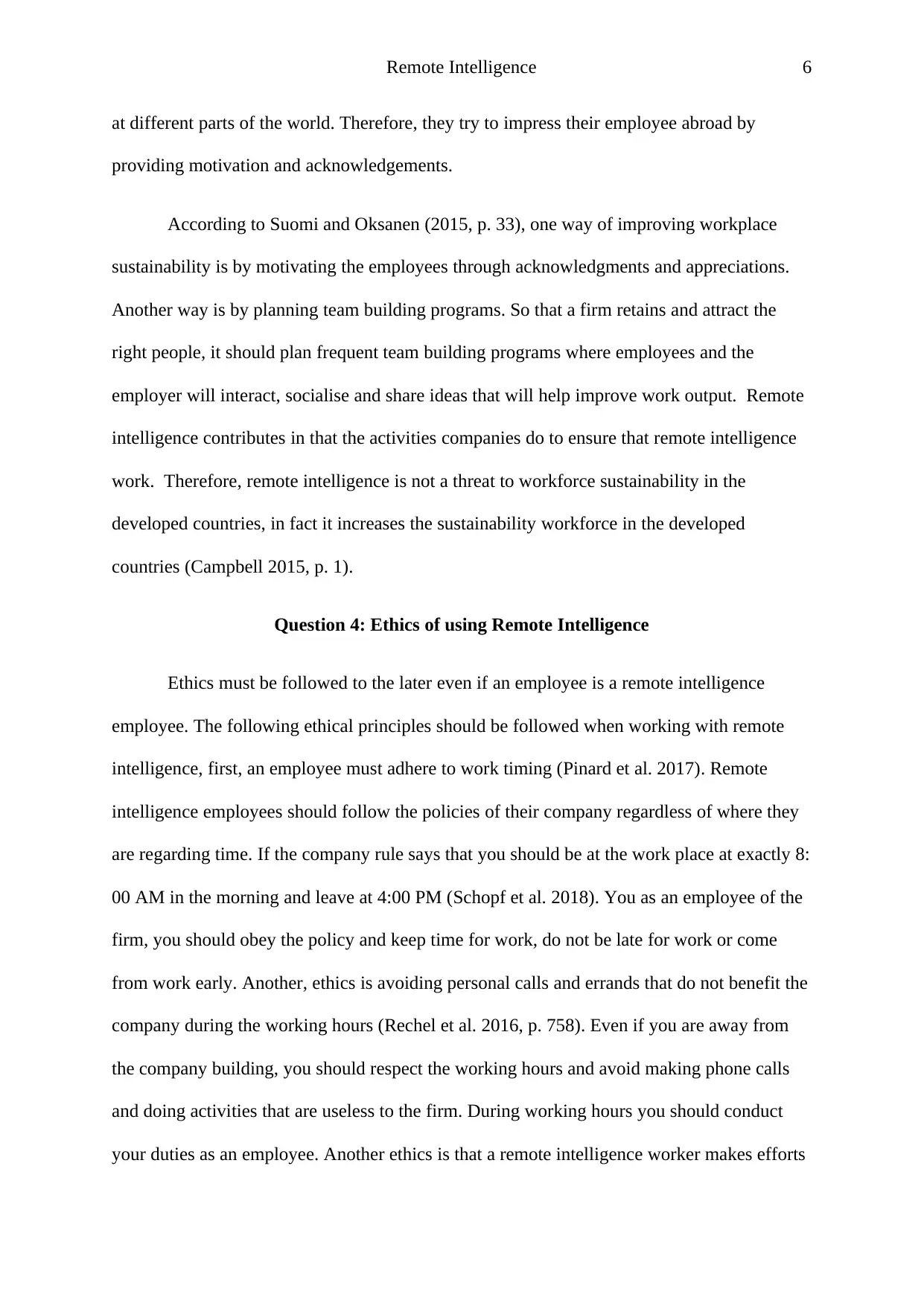
Remote Intelligence 6
at different parts of the world. Therefore, they try to impress their employee abroad by
providing motivation and acknowledgements.
According to Suomi and Oksanen (2015, p. 33), one way of improving workplace
sustainability is by motivating the employees through acknowledgments and appreciations.
Another way is by planning team building programs. So that a firm retains and attract the
right people, it should plan frequent team building programs where employees and the
employer will interact, socialise and share ideas that will help improve work output. Remote
intelligence contributes in that the activities companies do to ensure that remote intelligence
work. Therefore, remote intelligence is not a threat to workforce sustainability in the
developed countries, in fact it increases the sustainability workforce in the developed
countries (Campbell 2015, p. 1).
Question 4: Ethics of using Remote Intelligence
Ethics must be followed to the later even if an employee is a remote intelligence
employee. The following ethical principles should be followed when working with remote
intelligence, first, an employee must adhere to work timing (Pinard et al. 2017). Remote
intelligence employees should follow the policies of their company regardless of where they
are regarding time. If the company rule says that you should be at the work place at exactly 8:
00 AM in the morning and leave at 4:00 PM (Schopf et al. 2018). You as an employee of the
firm, you should obey the policy and keep time for work, do not be late for work or come
from work early. Another, ethics is avoiding personal calls and errands that do not benefit the
company during the working hours (Rechel et al. 2016, p. 758). Even if you are away from
the company building, you should respect the working hours and avoid making phone calls
and doing activities that are useless to the firm. During working hours you should conduct
your duties as an employee. Another ethics is that a remote intelligence worker makes efforts
at different parts of the world. Therefore, they try to impress their employee abroad by
providing motivation and acknowledgements.
According to Suomi and Oksanen (2015, p. 33), one way of improving workplace
sustainability is by motivating the employees through acknowledgments and appreciations.
Another way is by planning team building programs. So that a firm retains and attract the
right people, it should plan frequent team building programs where employees and the
employer will interact, socialise and share ideas that will help improve work output. Remote
intelligence contributes in that the activities companies do to ensure that remote intelligence
work. Therefore, remote intelligence is not a threat to workforce sustainability in the
developed countries, in fact it increases the sustainability workforce in the developed
countries (Campbell 2015, p. 1).
Question 4: Ethics of using Remote Intelligence
Ethics must be followed to the later even if an employee is a remote intelligence
employee. The following ethical principles should be followed when working with remote
intelligence, first, an employee must adhere to work timing (Pinard et al. 2017). Remote
intelligence employees should follow the policies of their company regardless of where they
are regarding time. If the company rule says that you should be at the work place at exactly 8:
00 AM in the morning and leave at 4:00 PM (Schopf et al. 2018). You as an employee of the
firm, you should obey the policy and keep time for work, do not be late for work or come
from work early. Another, ethics is avoiding personal calls and errands that do not benefit the
company during the working hours (Rechel et al. 2016, p. 758). Even if you are away from
the company building, you should respect the working hours and avoid making phone calls
and doing activities that are useless to the firm. During working hours you should conduct
your duties as an employee. Another ethics is that a remote intelligence worker makes efforts
⊘ This is a preview!⊘
Do you want full access?
Subscribe today to unlock all pages.

Trusted by 1+ million students worldwide
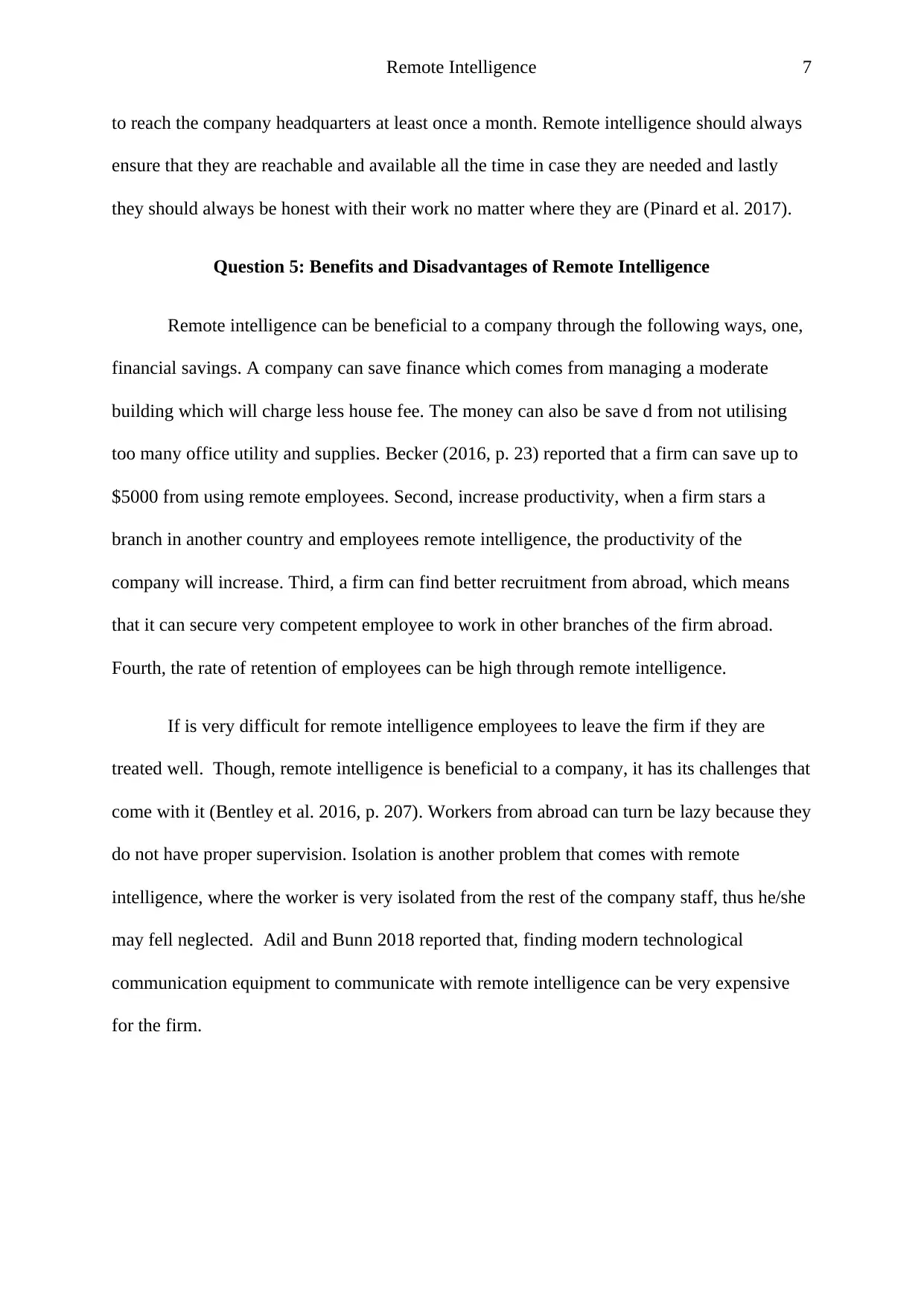
Remote Intelligence 7
to reach the company headquarters at least once a month. Remote intelligence should always
ensure that they are reachable and available all the time in case they are needed and lastly
they should always be honest with their work no matter where they are (Pinard et al. 2017).
Question 5: Benefits and Disadvantages of Remote Intelligence
Remote intelligence can be beneficial to a company through the following ways, one,
financial savings. A company can save finance which comes from managing a moderate
building which will charge less house fee. The money can also be save d from not utilising
too many office utility and supplies. Becker (2016, p. 23) reported that a firm can save up to
$5000 from using remote employees. Second, increase productivity, when a firm stars a
branch in another country and employees remote intelligence, the productivity of the
company will increase. Third, a firm can find better recruitment from abroad, which means
that it can secure very competent employee to work in other branches of the firm abroad.
Fourth, the rate of retention of employees can be high through remote intelligence.
If is very difficult for remote intelligence employees to leave the firm if they are
treated well. Though, remote intelligence is beneficial to a company, it has its challenges that
come with it (Bentley et al. 2016, p. 207). Workers from abroad can turn be lazy because they
do not have proper supervision. Isolation is another problem that comes with remote
intelligence, where the worker is very isolated from the rest of the company staff, thus he/she
may fell neglected. Adil and Bunn 2018 reported that, finding modern technological
communication equipment to communicate with remote intelligence can be very expensive
for the firm.
to reach the company headquarters at least once a month. Remote intelligence should always
ensure that they are reachable and available all the time in case they are needed and lastly
they should always be honest with their work no matter where they are (Pinard et al. 2017).
Question 5: Benefits and Disadvantages of Remote Intelligence
Remote intelligence can be beneficial to a company through the following ways, one,
financial savings. A company can save finance which comes from managing a moderate
building which will charge less house fee. The money can also be save d from not utilising
too many office utility and supplies. Becker (2016, p. 23) reported that a firm can save up to
$5000 from using remote employees. Second, increase productivity, when a firm stars a
branch in another country and employees remote intelligence, the productivity of the
company will increase. Third, a firm can find better recruitment from abroad, which means
that it can secure very competent employee to work in other branches of the firm abroad.
Fourth, the rate of retention of employees can be high through remote intelligence.
If is very difficult for remote intelligence employees to leave the firm if they are
treated well. Though, remote intelligence is beneficial to a company, it has its challenges that
come with it (Bentley et al. 2016, p. 207). Workers from abroad can turn be lazy because they
do not have proper supervision. Isolation is another problem that comes with remote
intelligence, where the worker is very isolated from the rest of the company staff, thus he/she
may fell neglected. Adil and Bunn 2018 reported that, finding modern technological
communication equipment to communicate with remote intelligence can be very expensive
for the firm.
Paraphrase This Document
Need a fresh take? Get an instant paraphrase of this document with our AI Paraphraser
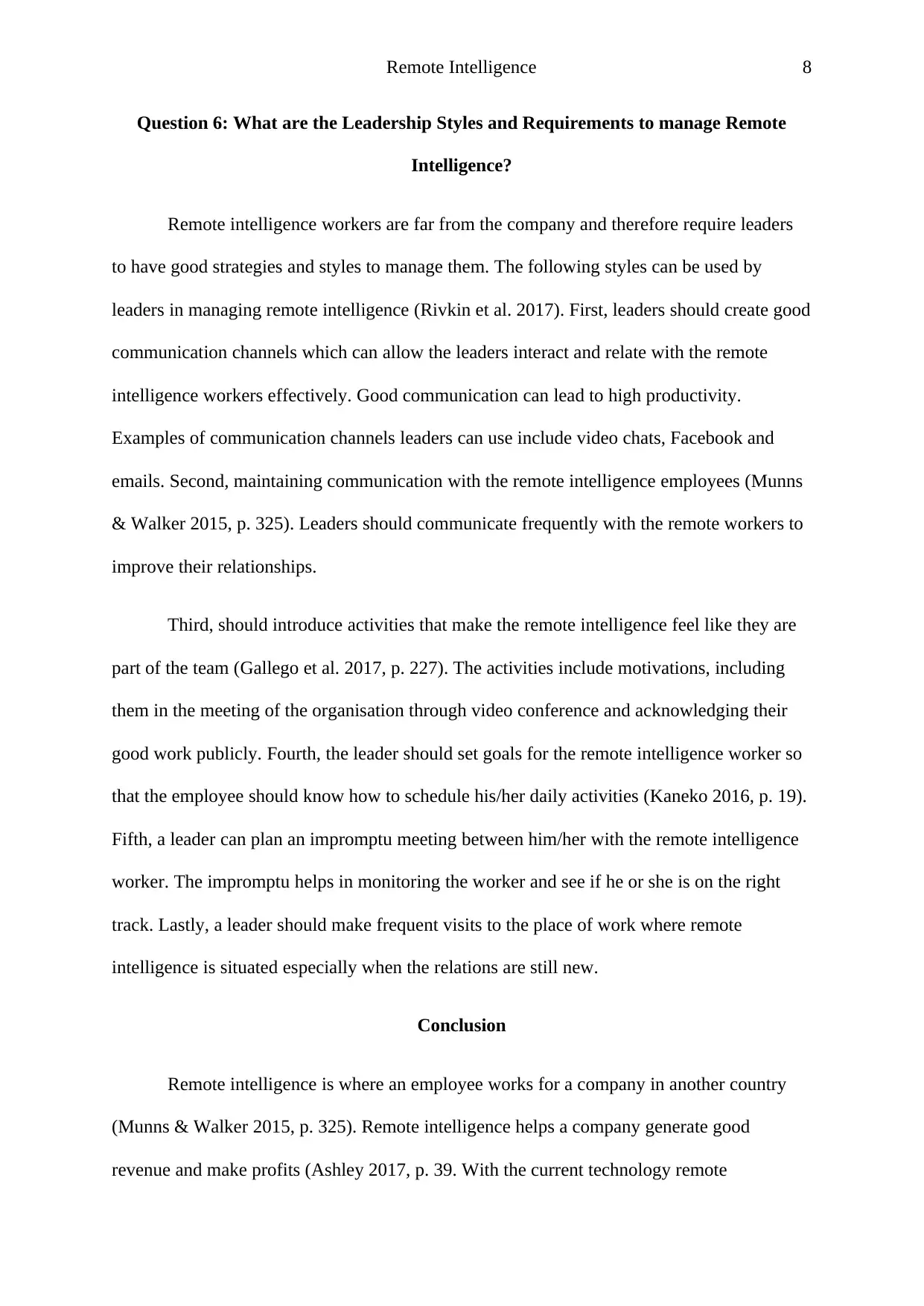
Remote Intelligence 8
Question 6: What are the Leadership Styles and Requirements to manage Remote
Intelligence?
Remote intelligence workers are far from the company and therefore require leaders
to have good strategies and styles to manage them. The following styles can be used by
leaders in managing remote intelligence (Rivkin et al. 2017). First, leaders should create good
communication channels which can allow the leaders interact and relate with the remote
intelligence workers effectively. Good communication can lead to high productivity.
Examples of communication channels leaders can use include video chats, Facebook and
emails. Second, maintaining communication with the remote intelligence employees (Munns
& Walker 2015, p. 325). Leaders should communicate frequently with the remote workers to
improve their relationships.
Third, should introduce activities that make the remote intelligence feel like they are
part of the team (Gallego et al. 2017, p. 227). The activities include motivations, including
them in the meeting of the organisation through video conference and acknowledging their
good work publicly. Fourth, the leader should set goals for the remote intelligence worker so
that the employee should know how to schedule his/her daily activities (Kaneko 2016, p. 19).
Fifth, a leader can plan an impromptu meeting between him/her with the remote intelligence
worker. The impromptu helps in monitoring the worker and see if he or she is on the right
track. Lastly, a leader should make frequent visits to the place of work where remote
intelligence is situated especially when the relations are still new.
Conclusion
Remote intelligence is where an employee works for a company in another country
(Munns & Walker 2015, p. 325). Remote intelligence helps a company generate good
revenue and make profits (Ashley 2017, p. 39. With the current technology remote
Question 6: What are the Leadership Styles and Requirements to manage Remote
Intelligence?
Remote intelligence workers are far from the company and therefore require leaders
to have good strategies and styles to manage them. The following styles can be used by
leaders in managing remote intelligence (Rivkin et al. 2017). First, leaders should create good
communication channels which can allow the leaders interact and relate with the remote
intelligence workers effectively. Good communication can lead to high productivity.
Examples of communication channels leaders can use include video chats, Facebook and
emails. Second, maintaining communication with the remote intelligence employees (Munns
& Walker 2015, p. 325). Leaders should communicate frequently with the remote workers to
improve their relationships.
Third, should introduce activities that make the remote intelligence feel like they are
part of the team (Gallego et al. 2017, p. 227). The activities include motivations, including
them in the meeting of the organisation through video conference and acknowledging their
good work publicly. Fourth, the leader should set goals for the remote intelligence worker so
that the employee should know how to schedule his/her daily activities (Kaneko 2016, p. 19).
Fifth, a leader can plan an impromptu meeting between him/her with the remote intelligence
worker. The impromptu helps in monitoring the worker and see if he or she is on the right
track. Lastly, a leader should make frequent visits to the place of work where remote
intelligence is situated especially when the relations are still new.
Conclusion
Remote intelligence is where an employee works for a company in another country
(Munns & Walker 2015, p. 325). Remote intelligence helps a company generate good
revenue and make profits (Ashley 2017, p. 39. With the current technology remote
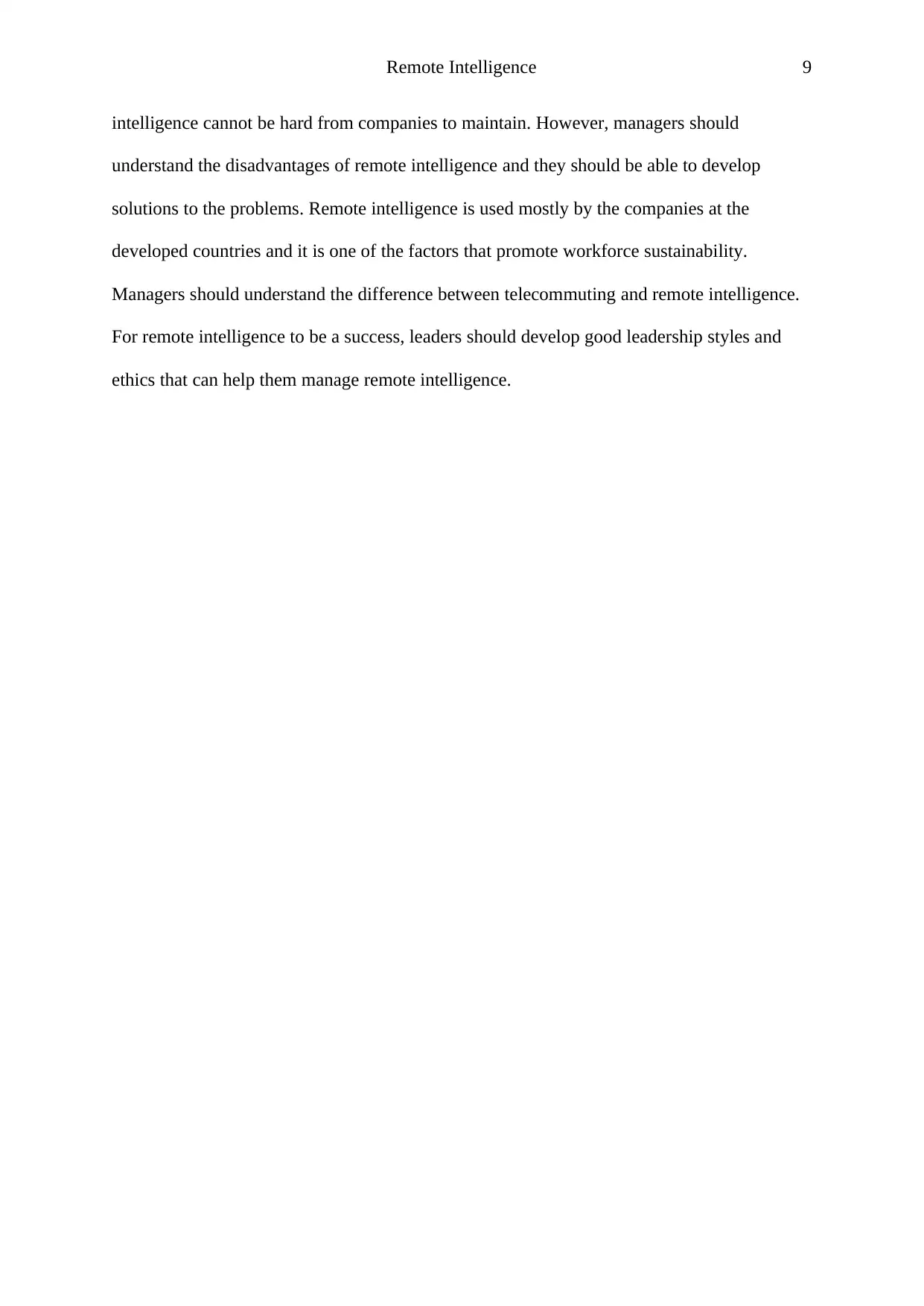
Remote Intelligence 9
intelligence cannot be hard from companies to maintain. However, managers should
understand the disadvantages of remote intelligence and they should be able to develop
solutions to the problems. Remote intelligence is used mostly by the companies at the
developed countries and it is one of the factors that promote workforce sustainability.
Managers should understand the difference between telecommuting and remote intelligence.
For remote intelligence to be a success, leaders should develop good leadership styles and
ethics that can help them manage remote intelligence.
intelligence cannot be hard from companies to maintain. However, managers should
understand the disadvantages of remote intelligence and they should be able to develop
solutions to the problems. Remote intelligence is used mostly by the companies at the
developed countries and it is one of the factors that promote workforce sustainability.
Managers should understand the difference between telecommuting and remote intelligence.
For remote intelligence to be a success, leaders should develop good leadership styles and
ethics that can help them manage remote intelligence.
⊘ This is a preview!⊘
Do you want full access?
Subscribe today to unlock all pages.

Trusted by 1+ million students worldwide
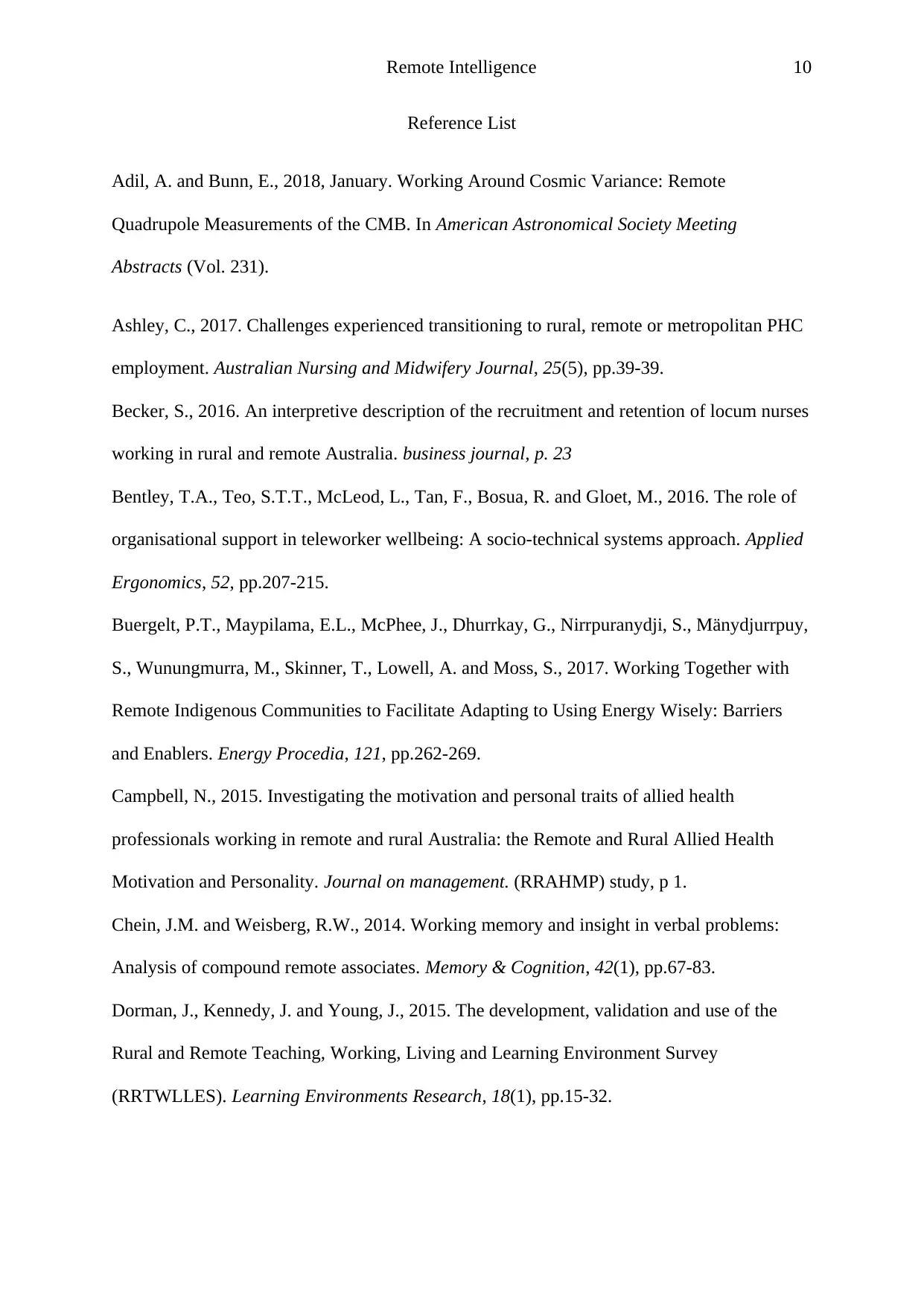
Remote Intelligence 10
Reference List
Adil, A. and Bunn, E., 2018, January. Working Around Cosmic Variance: Remote
Quadrupole Measurements of the CMB. In American Astronomical Society Meeting
Abstracts (Vol. 231).
Ashley, C., 2017. Challenges experienced transitioning to rural, remote or metropolitan PHC
employment. Australian Nursing and Midwifery Journal, 25(5), pp.39-39.
Becker, S., 2016. An interpretive description of the recruitment and retention of locum nurses
working in rural and remote Australia. business journal, p. 23
Bentley, T.A., Teo, S.T.T., McLeod, L., Tan, F., Bosua, R. and Gloet, M., 2016. The role of
organisational support in teleworker wellbeing: A socio-technical systems approach. Applied
Ergonomics, 52, pp.207-215.
Buergelt, P.T., Maypilama, E.L., McPhee, J., Dhurrkay, G., Nirrpuranydji, S., Mänydjurrpuy,
S., Wunungmurra, M., Skinner, T., Lowell, A. and Moss, S., 2017. Working Together with
Remote Indigenous Communities to Facilitate Adapting to Using Energy Wisely: Barriers
and Enablers. Energy Procedia, 121, pp.262-269.
Campbell, N., 2015. Investigating the motivation and personal traits of allied health
professionals working in remote and rural Australia: the Remote and Rural Allied Health
Motivation and Personality. Journal on management. (RRAHMP) study, p 1.
Chein, J.M. and Weisberg, R.W., 2014. Working memory and insight in verbal problems:
Analysis of compound remote associates. Memory & Cognition, 42(1), pp.67-83.
Dorman, J., Kennedy, J. and Young, J., 2015. The development, validation and use of the
Rural and Remote Teaching, Working, Living and Learning Environment Survey
(RRTWLLES). Learning Environments Research, 18(1), pp.15-32.
Reference List
Adil, A. and Bunn, E., 2018, January. Working Around Cosmic Variance: Remote
Quadrupole Measurements of the CMB. In American Astronomical Society Meeting
Abstracts (Vol. 231).
Ashley, C., 2017. Challenges experienced transitioning to rural, remote or metropolitan PHC
employment. Australian Nursing and Midwifery Journal, 25(5), pp.39-39.
Becker, S., 2016. An interpretive description of the recruitment and retention of locum nurses
working in rural and remote Australia. business journal, p. 23
Bentley, T.A., Teo, S.T.T., McLeod, L., Tan, F., Bosua, R. and Gloet, M., 2016. The role of
organisational support in teleworker wellbeing: A socio-technical systems approach. Applied
Ergonomics, 52, pp.207-215.
Buergelt, P.T., Maypilama, E.L., McPhee, J., Dhurrkay, G., Nirrpuranydji, S., Mänydjurrpuy,
S., Wunungmurra, M., Skinner, T., Lowell, A. and Moss, S., 2017. Working Together with
Remote Indigenous Communities to Facilitate Adapting to Using Energy Wisely: Barriers
and Enablers. Energy Procedia, 121, pp.262-269.
Campbell, N., 2015. Investigating the motivation and personal traits of allied health
professionals working in remote and rural Australia: the Remote and Rural Allied Health
Motivation and Personality. Journal on management. (RRAHMP) study, p 1.
Chein, J.M. and Weisberg, R.W., 2014. Working memory and insight in verbal problems:
Analysis of compound remote associates. Memory & Cognition, 42(1), pp.67-83.
Dorman, J., Kennedy, J. and Young, J., 2015. The development, validation and use of the
Rural and Remote Teaching, Working, Living and Learning Environment Survey
(RRTWLLES). Learning Environments Research, 18(1), pp.15-32.
Paraphrase This Document
Need a fresh take? Get an instant paraphrase of this document with our AI Paraphraser
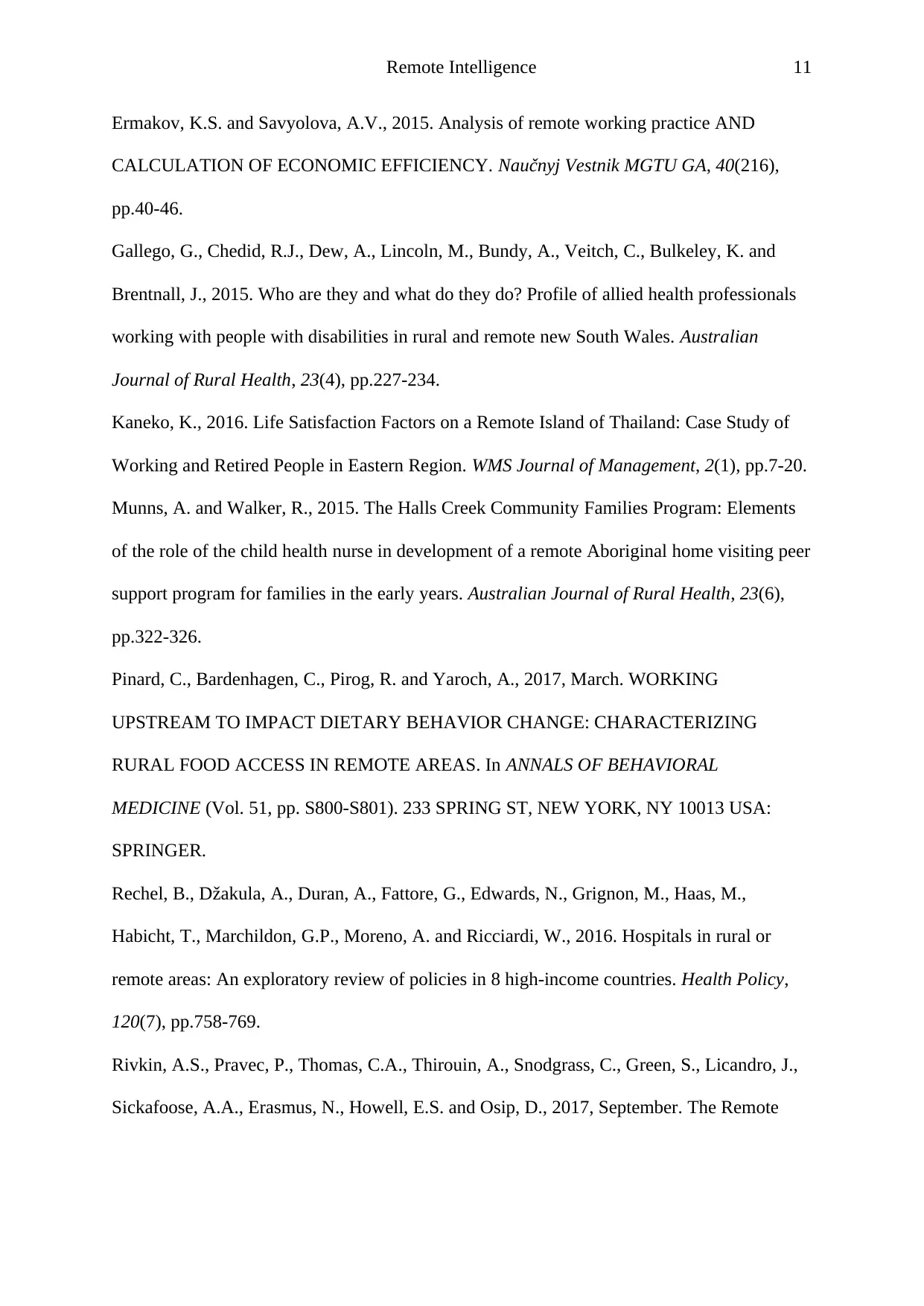
Remote Intelligence 11
Ermakov, K.S. and Savyolova, A.V., 2015. Analysis of remote working practice AND
CALCULATION OF ECONOMIC EFFICIENCY. Naučnyj Vestnik MGTU GA, 40(216),
pp.40-46.
Gallego, G., Chedid, R.J., Dew, A., Lincoln, M., Bundy, A., Veitch, C., Bulkeley, K. and
Brentnall, J., 2015. Who are they and what do they do? Profile of allied health professionals
working with people with disabilities in rural and remote new South Wales. Australian
Journal of Rural Health, 23(4), pp.227-234.
Kaneko, K., 2016. Life Satisfaction Factors on a Remote Island of Thailand: Case Study of
Working and Retired People in Eastern Region. WMS Journal of Management, 2(1), pp.7-20.
Munns, A. and Walker, R., 2015. The Halls Creek Community Families Program: Elements
of the role of the child health nurse in development of a remote Aboriginal home visiting peer
support program for families in the early years. Australian Journal of Rural Health, 23(6),
pp.322-326.
Pinard, C., Bardenhagen, C., Pirog, R. and Yaroch, A., 2017, March. WORKING
UPSTREAM TO IMPACT DIETARY BEHAVIOR CHANGE: CHARACTERIZING
RURAL FOOD ACCESS IN REMOTE AREAS. In ANNALS OF BEHAVIORAL
MEDICINE (Vol. 51, pp. S800-S801). 233 SPRING ST, NEW YORK, NY 10013 USA:
SPRINGER.
Rechel, B., Džakula, A., Duran, A., Fattore, G., Edwards, N., Grignon, M., Haas, M.,
Habicht, T., Marchildon, G.P., Moreno, A. and Ricciardi, W., 2016. Hospitals in rural or
remote areas: An exploratory review of policies in 8 high-income countries. Health Policy,
120(7), pp.758-769.
Rivkin, A.S., Pravec, P., Thomas, C.A., Thirouin, A., Snodgrass, C., Green, S., Licandro, J.,
Sickafoose, A.A., Erasmus, N., Howell, E.S. and Osip, D., 2017, September. The Remote
Ermakov, K.S. and Savyolova, A.V., 2015. Analysis of remote working practice AND
CALCULATION OF ECONOMIC EFFICIENCY. Naučnyj Vestnik MGTU GA, 40(216),
pp.40-46.
Gallego, G., Chedid, R.J., Dew, A., Lincoln, M., Bundy, A., Veitch, C., Bulkeley, K. and
Brentnall, J., 2015. Who are they and what do they do? Profile of allied health professionals
working with people with disabilities in rural and remote new South Wales. Australian
Journal of Rural Health, 23(4), pp.227-234.
Kaneko, K., 2016. Life Satisfaction Factors on a Remote Island of Thailand: Case Study of
Working and Retired People in Eastern Region. WMS Journal of Management, 2(1), pp.7-20.
Munns, A. and Walker, R., 2015. The Halls Creek Community Families Program: Elements
of the role of the child health nurse in development of a remote Aboriginal home visiting peer
support program for families in the early years. Australian Journal of Rural Health, 23(6),
pp.322-326.
Pinard, C., Bardenhagen, C., Pirog, R. and Yaroch, A., 2017, March. WORKING
UPSTREAM TO IMPACT DIETARY BEHAVIOR CHANGE: CHARACTERIZING
RURAL FOOD ACCESS IN REMOTE AREAS. In ANNALS OF BEHAVIORAL
MEDICINE (Vol. 51, pp. S800-S801). 233 SPRING ST, NEW YORK, NY 10013 USA:
SPRINGER.
Rechel, B., Džakula, A., Duran, A., Fattore, G., Edwards, N., Grignon, M., Haas, M.,
Habicht, T., Marchildon, G.P., Moreno, A. and Ricciardi, W., 2016. Hospitals in rural or
remote areas: An exploratory review of policies in 8 high-income countries. Health Policy,
120(7), pp.758-769.
Rivkin, A.S., Pravec, P., Thomas, C.A., Thirouin, A., Snodgrass, C., Green, S., Licandro, J.,
Sickafoose, A.A., Erasmus, N., Howell, E.S. and Osip, D., 2017, September. The Remote
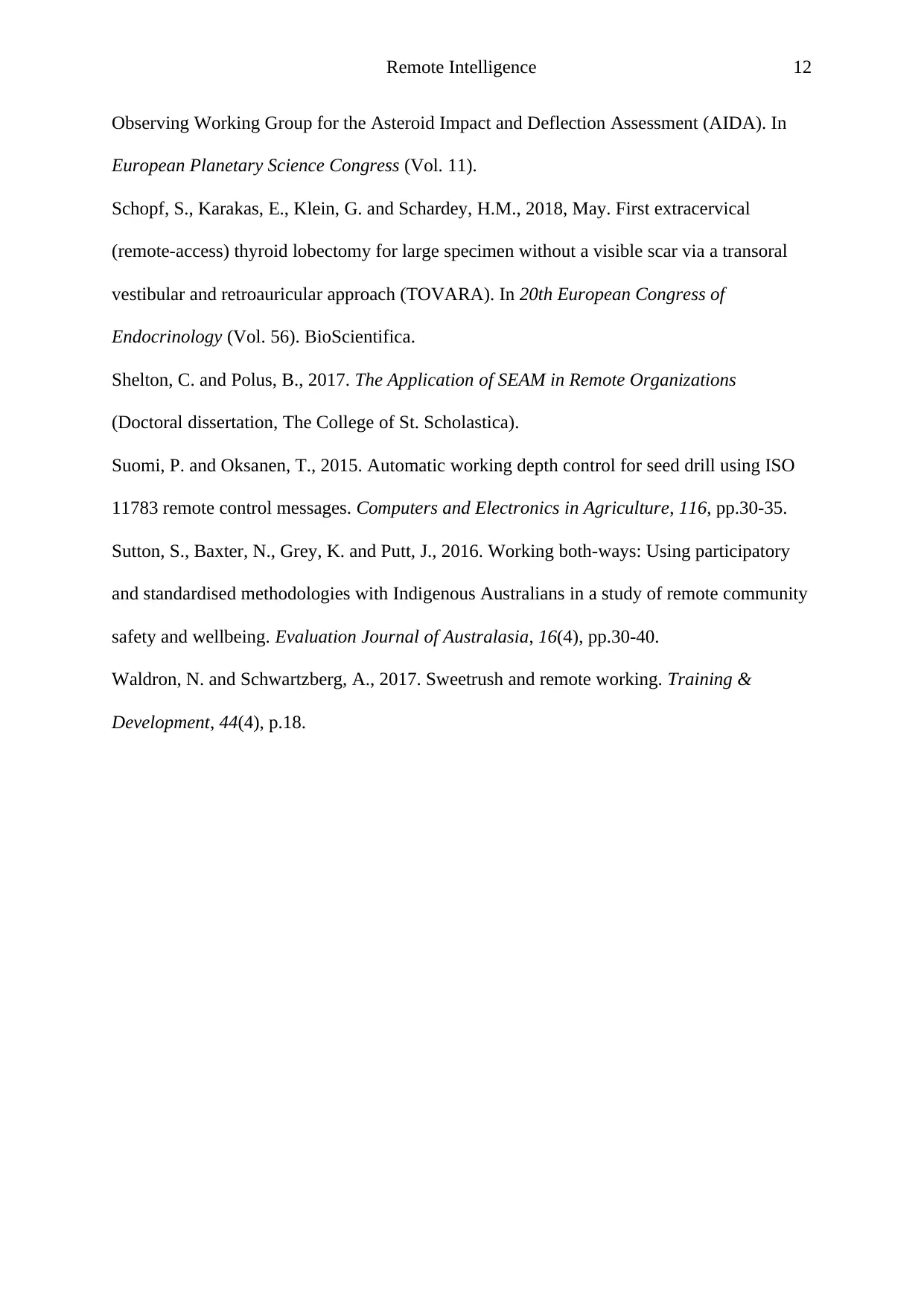
Remote Intelligence 12
Observing Working Group for the Asteroid Impact and Deflection Assessment (AIDA). In
European Planetary Science Congress (Vol. 11).
Schopf, S., Karakas, E., Klein, G. and Schardey, H.M., 2018, May. First extracervical
(remote-access) thyroid lobectomy for large specimen without a visible scar via a transoral
vestibular and retroauricular approach (TOVARA). In 20th European Congress of
Endocrinology (Vol. 56). BioScientifica.
Shelton, C. and Polus, B., 2017. The Application of SEAM in Remote Organizations
(Doctoral dissertation, The College of St. Scholastica).
Suomi, P. and Oksanen, T., 2015. Automatic working depth control for seed drill using ISO
11783 remote control messages. Computers and Electronics in Agriculture, 116, pp.30-35.
Sutton, S., Baxter, N., Grey, K. and Putt, J., 2016. Working both-ways: Using participatory
and standardised methodologies with Indigenous Australians in a study of remote community
safety and wellbeing. Evaluation Journal of Australasia, 16(4), pp.30-40.
Waldron, N. and Schwartzberg, A., 2017. Sweetrush and remote working. Training &
Development, 44(4), p.18.
Observing Working Group for the Asteroid Impact and Deflection Assessment (AIDA). In
European Planetary Science Congress (Vol. 11).
Schopf, S., Karakas, E., Klein, G. and Schardey, H.M., 2018, May. First extracervical
(remote-access) thyroid lobectomy for large specimen without a visible scar via a transoral
vestibular and retroauricular approach (TOVARA). In 20th European Congress of
Endocrinology (Vol. 56). BioScientifica.
Shelton, C. and Polus, B., 2017. The Application of SEAM in Remote Organizations
(Doctoral dissertation, The College of St. Scholastica).
Suomi, P. and Oksanen, T., 2015. Automatic working depth control for seed drill using ISO
11783 remote control messages. Computers and Electronics in Agriculture, 116, pp.30-35.
Sutton, S., Baxter, N., Grey, K. and Putt, J., 2016. Working both-ways: Using participatory
and standardised methodologies with Indigenous Australians in a study of remote community
safety and wellbeing. Evaluation Journal of Australasia, 16(4), pp.30-40.
Waldron, N. and Schwartzberg, A., 2017. Sweetrush and remote working. Training &
Development, 44(4), p.18.
⊘ This is a preview!⊘
Do you want full access?
Subscribe today to unlock all pages.

Trusted by 1+ million students worldwide
1 out of 12
Related Documents
Your All-in-One AI-Powered Toolkit for Academic Success.
+13062052269
info@desklib.com
Available 24*7 on WhatsApp / Email
![[object Object]](/_next/static/media/star-bottom.7253800d.svg)
Unlock your academic potential
Copyright © 2020–2025 A2Z Services. All Rights Reserved. Developed and managed by ZUCOL.




